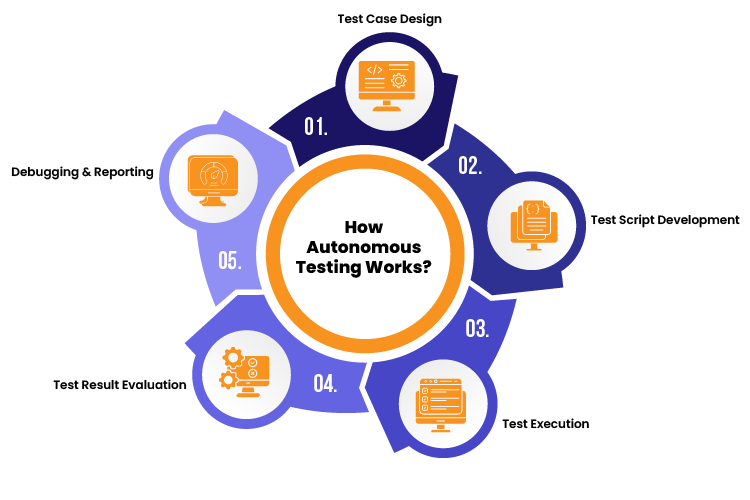

Acl Digital
8 Minutes read
Revolutionizing Software Testing with Automated Test Generation (ATG)
In an era where software is the backbone of every industry, the pressure to deliver reliable, secure, and high-quality products is greater than ever. As organizations increasingly rely on software to meet their business needs, the demand for more effective and scalable testing solutions has skyrocketed. Manual testing and automated scripting cannot be enough to ensure software is defect-free while meeting fast-paced requirements of modern development cycles. These methods are often seen as costly and slow, unable to keep pace with the complexities of today’s software ecosystems.
This challenge has given rise to Autonomous Test Generation (ATG)—a cutting-edge approach powered by advancements in artificial intelligence (AI) and machine learning (ML). By automatically generating test cases and minimizing human intervention, ATG drastically improves testing efficiency, reduces costs, and enhances accuracy. Following are the key statistics on Autonomous Test Generation:
- The ATG market is projected to reach $89.81 billion USD by 2030 due to growing demand for faster, more efficient testing.
- ATG tools can significantly enhance testing coverage, identifying issues much earlier in the development process.
- With minimal human intervention, tests can be generated and executed at much faster speeds, reducing time-to-market for software products.
- Adoption of ATG tools is expected to increase by more than 20% annually, as companies prioritize automation in quality assurance.
How Autonomous Testing Works?
Autonomous software testing utilizes various software tools and frameworks to replicate user behaviors, input data, and expected outcomes without requiring human involvement. The typical process includes the following steps:

Test Case Design
Test cases are created to emulate user actions and input data. They may be designed manually or automatically generated by examining the application’s code or user interface.
Test Script Development
Developers write test scripts in programming languages such as Python, Java, or C# to automate the execution of these test cases. These scripts leverage testing frameworks and libraries to interact with the application effectively.
Test Execution
The test scripts are run automatically by a test execution engine or integrated within a Continuous Integration/Continuous Deployment (CI/CD) pipeline. This step replicates user actions and continuously validates the application as updates are implemented.
Test Result Evaluation
The testing framework assesses the actual results against the expected outcomes, employing AI to identify patterns in failures and enhance future testing efforts.
Debugging and Reporting
AI tools categorize defects, conduct root cause analysis, and provide suggestions for fixes. The results are automatically conveyed to the development team through dashboards or notifications.
How ATG Streamlines Software Testing
ATG tools automate the creation of test cases, eliminating the need for manual generation, which accelerates the software development timeline. ATG can generate test scenarios from multiple sources, including requirements, models, and actual code, ensuring broad and thorough test coverage. By integrating ATG tools into CI/CD pipelines, automated testing becomes continuous, significantly speeding up the delivery of high-quality software. The automation and speed provided by ATG tools are especially beneficial for agile and DevOps environments, where rapid development and continuous delivery are key priorities.
Benefits of Using Autonomous Test Generation in Software Testing
Autonomous testing tools have come to be a significant solution, utilizing automation and advanced technologies to transform the testing landscape. By minimizing manual intervention and enhancing accuracy, these tools not only streamline the testing process but also contribute significantly to overall software quality. The following benefits highlight why autonomous testing tools are becoming essential for modern software testing practices.
Automatic Locator Updates with UI Changes
Autonomous test generation tools can automatically update element locators whenever UI changes, whether on the web or mobile apps. This is especially useful for apps that update frequently, as it prevents tests from breaking due to new UI elements or layout changes. By keeping locators up to date, these tools reduce the need for manual adjustments, making tests more reliable and saving maintenance time.
Accurate Test Coverage
Autonomous testing tools are capable of executing numerous test cases that encompass a wide range of complex and edge scenarios, which are often overlooked in manual or traditional automated testing. This results in significantly improved test coverage.
Accelerated Testing Cycles
With a high degree of automation in test suites, autonomous tests can run much more quickly than both manual and automated tests. This efficiency allows software testers to assess the software system in a shorter time frame, thereby reducing the overall testing cycle.
Minimized Human Error
Traditional manual and automated testing processes frequently necessitate significant human involvement, increasing the likelihood of errors such as incorrect test data, coding mistakes in test scripts, and execution or configuration errors. By minimizing human intervention, autonomous testing enhances accuracy and reliability.
Cost-Effective Solutions
Autonomous testing tools can lead to significant savings in labor, setup, and maintenance costs, making them a more economical option for organizations.
Improved Performance Benchmarking
These tools can perform rigorous performance tests under substantial production loads, identifying potential performance issues in the software and facilitating optimization.
Ongoing Learning and Enhancement
Autonomous testing tools can analyze the history of test executions to identify recurring issues, fostering continuous learning and refinement in the testing process, thus enhancing overall efficiency and effectiveness.
Essential Autonomous Testing Tools
| Tool | Key Features |
| Appvance |
|
| Testim |
|
| testRigor |
|
| Mable |
|
| Functionize |
|
The Importance of Combining Autonomous Test Generation with Other Testing Techniques
- Autonomous test generation enhances coverage but must be combined with manual testing and other techniques (e.g., unit, integration) to address both functional and non-functional requirements.
- Domain knowledge and expert-guided testing ensure that test cases reflect real-world scenarios, capturing nuances that autonomous testing alone may not capture.
- Autonomous test generation efficiently creates new tests but should be integrated with test case prioritization and regression testing to maintain and update test suites over time.
- Techniques like mutation testing help improve the quality of autonomously generated test cases, ensuring higher defect detection and enhancing overall test strategy maturity.
Industries Benefiting from Autonomous Software Testing
Several industries are experiencing significant advantages from the enhanced speed and efficiency provided by autonomous software testing. Here’s how different sectors benefit:
Financial Services
Autonomous testing is crucial for assessing complex security systems and transaction processes, helping to uncover vulnerabilities and ensure adherence to regulatory standards. This safeguards sensitive financial information while also minimizing the likelihood of errors and ensuring compliance with necessary regulations.
Healthcare
In the healthcare sector, autonomous testing simplifies the validation process for critical systems, including electronic health records (EHR) and patient management software. This ensures that medical applications function accurately and consistently, upholding high standards for patient safety and care while ensuring compliance with HIPAA regulations.
Retail
Autonomous testing improves the functionality of e-commerce platforms and inventory management systems. By leveraging this technology, retailers can deliver a seamless shopping experience and effectively oversee their stock levels.
Automotive
Within the automotive industry, autonomous testing plays a vital role in verifying the reliability of vehicle software. It ensures that safety features and infotainment systems perform as intended, contributing to overall vehicle safety and user satisfaction.
Conclusion
The use of AI and ML to generate autonomous tests offers transformative benefits in efficiency, scalability, and software quality. While it enhances testing automation and fosters confidence in software releases, challenges like incomplete requirements and integration with existing processes remain. To achieve comprehensive results, autonomous test generation should be combined with other testing techniques. By addressing these challenges, the industry can harness AI-driven testing to deliver reliable, high-quality software that meets evolving digital demands.
ACL Digital offers advanced AI and ML solutions to improve operations, including predictive analytics and intelligent automation. Using AI/ML technologies, your business can make informed decisions by providing personalized recommendations and data-driven insights.
For the latest updates or additional information, feel free to contact ACL Digital.





